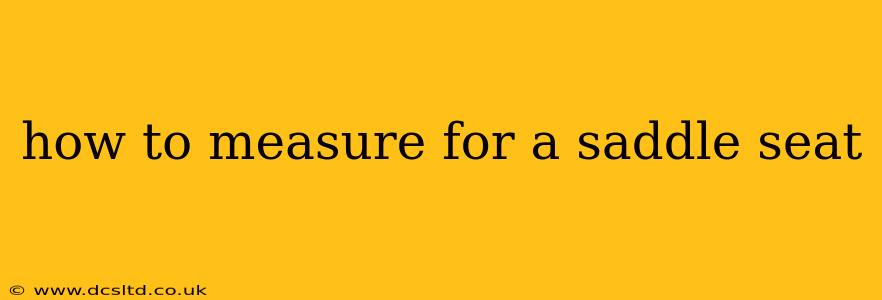Finding the perfect saddle seat is crucial for comfort, performance, and injury prevention. Whether you're a seasoned equestrian or a new rider, accurately measuring for a saddle seat ensures a proper fit. This guide will walk you through the process, addressing common questions and providing valuable tips.
What are the Key Measurements for a Saddle Seat?
Before diving into the specifics, it's important to understand that there isn't one single measurement that dictates saddle seat fit. Instead, several factors must be considered to determine the appropriate size and style. These include:
- Seat Size: This refers to the width of the saddle seat itself, typically measured in inches. A larger seat size offers more room, while a smaller size provides a closer, more secure feel.
- Tree Length: This measurement, often overlooked, is the distance from the front of the saddle to the back. An incorrect tree length can create discomfort and interfere with the horse's movement. This isn't something you directly measure yourself but is crucial information when purchasing or customizing.
- Rider's Weight & Build: A saddle must be able to comfortably support the rider's weight. Furthermore, a rider's build (tall and slender versus short and stocky) impacts the appropriate seat size and panel design.
- Horse's Back: While this is not a direct saddle seat measurement, the horse's conformation plays a critical role. The saddle needs to fit the horse's back properly, distributing weight evenly and preventing pressure points. An ill-fitting saddle for the horse can indirectly impact the seat's effectiveness.
How Do I Measure My Seat Size?
There's no precise at-home measurement to determine your ideal seat size. Many saddle manufacturers provide size charts, but these can vary. The best approach is to:
- Try Different Saddles: The most reliable method is to try several saddles with varying seat sizes. Sit in each one and assess your comfort level. Do you feel secure and balanced? Is there sufficient room, or do you feel cramped?
- Consult a Saddle Fitter: A professional saddle fitter can assess your body type, riding style, and the shape of your pelvis to recommend the best seat size. They can consider your posture and ensure that the saddle supports your weight correctly.
- Consider Your Riding Discipline: Different riding disciplines often call for different seat sizes and saddle styles. For example, a dressage saddle might have a slightly smaller seat than a western saddle.
What about the Tree Length? How Do I Measure That?
You generally don't measure the tree length yourself. This is a measurement taken by a saddle fitter or professional. They will assess your horse's back length and conformation to determine the appropriate tree length. This is crucial for the saddle to fit the horse correctly, regardless of the rider's seat size.
How Does My Horse's Back Affect the Saddle Seat Fit?
The horse's back shape and size directly impact the saddle fit and, consequently, the effectiveness of the saddle seat for the rider. A poorly fitted saddle can cause discomfort and even injury to the horse. A properly fitting saddle will:
- Distribute weight evenly: Preventing undue pressure on any one area of the horse's back.
- Allow for freedom of movement: The horse shouldn't be restricted or hindered by the saddle.
- Avoid pressure points: The saddle should lie flat and comfortably against the horse's back.
A saddle fitter can assess your horse's conformation and determine the correct saddle tree length and width. They may also recommend specific panel designs to accommodate the horse's back shape.
What if I am between sizes?
If you find yourself between sizes, it's generally best to choose the slightly larger size. A slightly larger seat offers more room and comfort, reducing the risk of cramping or discomfort during longer rides. However, it shouldn't be so large as to make you feel insecure or unstable.
Can I Use a Saddle Seat Without a Full Saddle?
While some specialized equipment might offer saddle seat-like support without a full saddle, these are usually for specific purposes and not suitable for general riding. A full saddle is essential for distributing weight properly and protecting the horse's back.
Remember, proper saddle fit for both horse and rider is paramount. Consulting a professional saddle fitter is always recommended to ensure optimal comfort, performance, and the well-being of both you and your horse.
